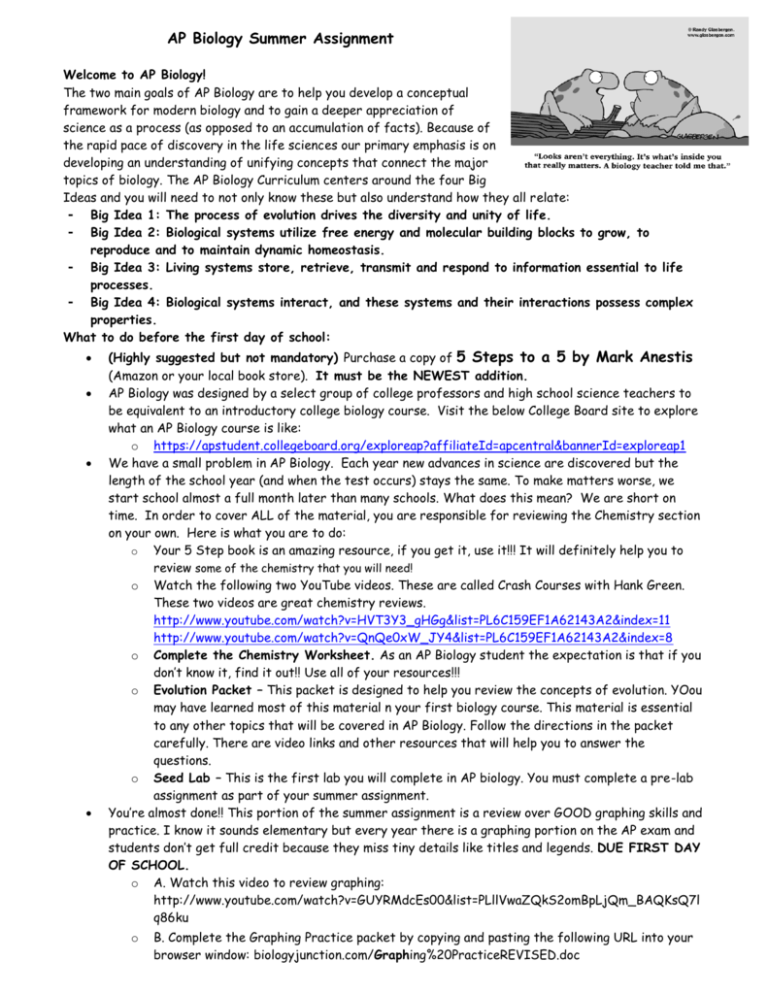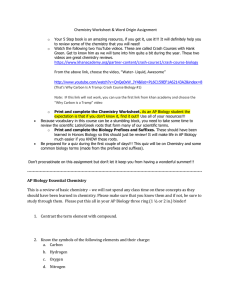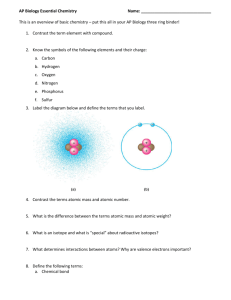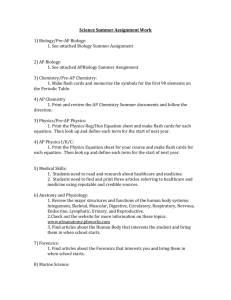AP Biology - Skyview High School
advertisement

AP Biology Summer Assignment Welcome to AP Biology! The two main goals of AP Biology are to help you develop a conceptual framework for modern biology and to gain a deeper appreciation of science as a process (as opposed to an accumulation of facts). Because of the rapid pace of discovery in the life sciences our primary emphasis is on developing an understanding of unifying concepts that connect the major topics of biology. The AP Biology Curriculum centers around the four Big Ideas and you will need to not only know these but also understand how they all relate: - Big Idea 1: The process of evolution drives the diversity and unity of life. - Big Idea 2: Biological systems utilize free energy and molecular building blocks to grow, to reproduce and to maintain dynamic homeostasis. - Big Idea 3: Living systems store, retrieve, transmit and respond to information essential to life processes. - Big Idea 4: Biological systems interact, and these systems and their interactions possess complex properties. What to do before the first day of school: (Highly suggested but not mandatory) Purchase a copy of 5 Steps to a 5 by Mark Anestis (Amazon or your local book store). It must be the NEWEST addition. AP Biology was designed by a select group of college professors and high school science teachers to be equivalent to an introductory college biology course. Visit the below College Board site to explore what an AP Biology course is like: o https://apstudent.collegeboard.org/exploreap?affiliateId=apcentral&bannerId=exploreap1 We have a small problem in AP Biology. Each year new advances in science are discovered but the length of the school year (and when the test occurs) stays the same. To make matters worse, we start school almost a full month later than many schools. What does this mean? We are short on time. In order to cover ALL of the material, you are responsible for reviewing the Chemistry section on your own. Here is what you are to do: o Your 5 Step book is an amazing resource, if you get it, use it!!! It will definitely help you to review some of the chemistry that you will need! o Watch the following two YouTube videos. These are called Crash Courses with Hank Green. These two videos are great chemistry reviews. http://www.youtube.com/watch?v=HVT3Y3_gHGg&list=PL6C159EF1A62143A2&index=11 http://www.youtube.com/watch?v=QnQe0xW_JY4&list=PL6C159EF1A62143A2&index=8 o Complete the Chemistry Worksheet. As an AP Biology student the expectation is that if you don’t know it, find it out!! Use all of your resources!!! o Evolution Packet – This packet is designed to help you review the concepts of evolution. YOou may have learned most of this material n your first biology course. This material is essential to any other topics that will be covered in AP Biology. Follow the directions in the packet carefully. There are video links and other resources that will help you to answer the questions. o Seed Lab – This is the first lab you will complete in AP biology. You must complete a pre-lab assignment as part of your summer assignment. You’re almost done!! This portion of the summer assignment is a review over GOOD graphing skills and practice. I know it sounds elementary but every year there is a graphing portion on the AP exam and students don’t get full credit because they miss tiny details like titles and legends. DUE FIRST DAY OF SCHOOL. o A. Watch this video to review graphing: http://www.youtube.com/watch?v=GUYRMdcEs00&list=PLllVwaZQkS2omBpLjQm_BAQKsQ7l q86ku o B. Complete the Graphing Practice packet by copying and pasting the following URL into your browser window: biologyjunction.com/Graphing%20PracticeREVISED.doc You can expect a quiz over Chemistry, Evolution & Graphing assignments the first week of school o Finally…………….Complete the AP BIOLOGY SURVEY I truly am looking forward to working with you next year! Don’t procrastinate on this assignment but don’t let it keep you from having a wonderful summer!!! ~ Mrs. Mills AP Biology Essential Chemistry This is a review of basic chemistry – we will not spend any class time on these concepts as they should have been learned in chemistry. Please make sure that you know them and if not, be sure to study through them. Please put this all in your AP Biology three ring (1 ½ or 2 in.) binder! 1. Contrast the term element with compound. 2. Know the symbols of the following elements and their charge: a. Carbon b. Hydrogen c. Oxygen d. Nitrogen e. Phosphorus f. Sulfur 3. Label the diagram below and define the terms that you label. 4. Contrast the terms atomic mass and atomic number. 5. What is the difference between the terms atomic mass and atomic weight? 6. What is an isotope and what is “special” about radioactive isotopes? 7. What determines interactions between atoms? Why are valence electrons important? 8. Define the following terms: a. Chemical bond b. Covalent bond c. Single bond d. Double bond e. Electronegativity f. Nonpolar covalent bond g. Polar covalent bond 9. What is the difference between a structural and molecular formula? 10. Know both the molecular and structural formula for the following compounds. a. Oxygen gas b. Carbon dioxide c. Glucose d. Phosphate e. Ammonia f. Water (you would be surprised at how many people missed this!!!) 11. How do ionic bonds compare with covalent bonds? 12. Compare and contrast hydrogen bonds and van der Waals interactions. 13. Define a dynamic chemical equilibrium in terms of quantities of reactants and products. This is a critical concept! 14. Why is water considered a polar molecule? 15. For each of the below listed properties of water – briefly define the property and then explain how water’s polar nature and polar covalent bonds contribute to the water special property. a. Cohesion b. Adhesion c. Surface tension d. High specific heat e. Heat of vaporization f. Evaporative cooling 16. What is special about water and density? 17. Explain how these properties of water are related to the phenomena described in the statements below. More than one property may be used to explain a given phenomenon. a. During the winter, air temperatures in the northern United States can remain below 0°C for months; however, the fish and other animals living in the lakes survive. b. Many substances—for example, salt (NaCl) and sucrose—dissolve quickly in water. c. When you pour water into a 25-ml graduated cylinder, a meniscus forms at the top of the water column. d. Sweating and the evaporation of sweat from the body surface help reduce a human’s body temperature. e. Water drops that fall on a surface tend to form rounded drops or beads. f. Water drops that fall on your car tend to bead or round up more after you polish (or wax) the car than before you polished it. g. If you touch the edge of a paper towel to a drop of colored water, the water will move up into (or be absorbed by) the towel. 18. Define the following terms: a. Solute b. Solvent c. Aqueous solution d. Hydrophilic e. Hydrophobic f. Molarity 19. MOLARITY A. Concentration – comparison of solute to solvent ( solute : solvent) a. Concentrated – large ratio of solute to solvent b. Dilute – small ratio of solute to solvent B. Molarity – a. Symbol – M mass b. Equation – in reference table M = moles of solute M= molar mass L of solution L of solution C. Example Problems 1. What is the molarity of a solution formed by 2. To prepare 10.5 L of a 2.50 M solution of KOH, mixing 10.0 g of H2SO4 with enough water to how many grams of potassium hydroxide must make 0.100 L of solution? be used? 3. How many moles of LiBr must be added to .650 L of water to make a 2.0 M solution? 4. What is the molarity of the solution produced when 145 g of NaCl is dissolved in sufficient water to prepare 2.75 L of solution? 5. How many grams of KCl are needed to prepare 0.750 L of a 1.50 M solution? 6. What is the molarity of the solution produced when .594 mol of HCl is dissolved in 0.385 L of water? 7. To produce 3.00 L of a 1.90 M solution of sodium hydroxide, how many grams of NaOH must be dissolved? 8. If 8.77 g of KI are dissolved in enough water to make 4.75 L of solution, what is the molarity of the solution? 20. Label the diagram below to demonstrate the dissociation of the water molecule and then relate this diagram to the term pH. 21. What defines an acid and a base? 22. Why are small changes in pH so important in biology? 23. What is a buffer? Give an example on how they would work in a living organism. 24. What is acid precipitation and why is it important to living organisms? 25. Why is organic chemistry so important in the study of biology? 26. What is special about carbon that makes it the central atom in the chemistry of life? 27. Describe and contrast the three types of isomers. Draw a sketch of each a. Structural – b. Geometric – c. Enantiomers – 28. Be familiar with each of the following functional groups – know it’s chemical compound and the functional properties a. Hydroxyl b. Carbonyl c. Carboxyl d. Amino e. Sulfhydryl f. Phosphate







